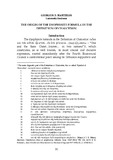| dc.description.abstract | The dyophysite formula in the Definition of Chalcedon («ἕνα καί τόν αὐτόν Χριστόν…ἐν δύο φύσεσιν…γνωριζόμενον» – “One and the Same Christ…known… in two natures”) , which constitutes, as is well known, its most crucial and decisive expression, existed immediately after the Fourth Ecumenical Council a controversial point among its Orthodox supporters and their anti-Chalcedonian opponents. This fact is not unexplainable, because at first glance this formula does not have any connection to Cyril of Alexandria, who was considered by the anti-Chalcedonians as the sole and undisputable authority for the solution of the Christological problem; moreover, it seems and strikingly resembles some particular dyophysite expressions used by Nestorius.
However, as we will see in the development of our subject, the direct source of this dyophysite formula was not Nestorian, but, as proven more convincingly by modern research, is completely Orthodox, especially with a very clear Cyrillian character: it is the Confession formulated by Basil of Seleucia at the Endemousa Synod of 448, who generates this formula from the Epistle of Cyril to John of Antioch . In other words, this formula, before its use by Basil of Seleucia and the Fathers of Chalcedon, with its Orthodox, and of course with its Cyrillian meaning, had been understood and used by the very same Nestorius with a divisible Christological meaning.
Let us look into more detail at the concept, which was the formula used by Nestorius, and the concept which was used both by Basil of Seleucia in his above-mentioned Confession and by the Fathers of Chalcedon in the Definition of Faith they drafted. | en_UK |


